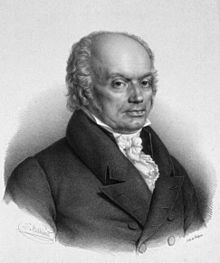Franz Joseph Gall facts for kids
Quick facts for kids
Franz Gall
|
|
|---|---|

Franz Joseph Gall
|
|
| Born | 9 March 1758 Tiefenbronn, Baden
|
| Died | 22 August 1828 (aged 70) Paris, France
|
| Nationality | German |
| Scientific career | |
| Fields | Neuroanatomist Physiologist |
| Influenced | Cesare Lombroso Alexandre Lacassagne Johann Gaspar Spurzheim |
Franz Josef Gall (German: [gal]; 9 March 1758 – 22 August 1828) was a German scientist. He studied the brain and how different parts might control different abilities. He was a neuroanatomist, which means he studied the brain's structure. He was also a physiologist, studying how living things work.
Gall is known for starting a field called phrenology. This idea suggested that a person's personality and skills could be told by the shape and bumps on their skull. While phrenology is now seen as a pseudoscience (not real science), Gall's work helped start the study of the brain. His ideas also played a part in how we think about human behavior and evolution today.
Contents
Early Life and Discoveries
Gall was born in a village called Tiefenbronn. His family was wealthy and important in the area. He was one of 12 children. From a young age, Gall was curious about people. He noticed how different his siblings and classmates were.
He became very interested in the brain. He once noticed a classmate with an unusual skull shape who was very good at languages. This made him wonder if the shape of the head was linked to certain skills. He also enjoyed collecting and sorting plants and animals. This helped him learn the importance of careful observation in science.
Education and Early Career
Gall was supposed to become a priest, but he chose to study medicine instead. He went to the University of Strasbourg. There, he continued his observations. He saw that many smart students had noticeable eyeballs. He thought this might be more than a coincidence.
He finished his medical degree in Vienna, Austria. His teachers taught him to observe things in nature very closely. His first job was at a hospital for people with mental health challenges. He then opened his own successful private practice. He even gave popular public lectures. He chose to focus on his research rather than taking a high-ranking job as a court physician.
What Was Phrenology?
Based on his early ideas about skull shapes, Gall developed a theory called Organology. He also created a method called Cranioscopy. These ideas later became known as Phrenology. Gall believed that the mind was made of many separate parts, each located in a different area of the brain.
Cranioscopy was a way to guess someone's personality and mental skills by feeling the outside of their skull. Gall thought that bumps and uneven spots on the skull were caused by the brain pushing outwards. He divided the brain into sections, each linked to a specific behavior or trait. He called these "fundamental faculties."
Gall believed there were 27 of these faculties. They included things like remembering people, mechanical ability, a talent for poetry, and even a strong desire for property. By feeling a person's skull, Gall thought he could understand their character. He studied over 120 skulls to test his ideas.
Gall did not agree with some other scientists who thought a bigger brain always meant more intelligence. However, after many dissections, he did conclude that a very small skull (under 14 inches around) usually meant a person could not function normally.
Working with Johann Spurzheim
In 1800, a scientist named Johann Spurzheim attended one of Gall's lectures. Spurzheim later became Gall's assistant. By 1804, he was Gall's full-time research partner. They worked together for years, developing ideas about how different brain parts have different jobs. In 1813, Spurzheim left Gall to work on his own. It was Spurzheim who gave the name phrenology to Gall's theories.
Other Important Work
Besides phrenology, Gall made other important contributions. While studying how the brain works, he greatly improved how scientists dissected brains. Before Gall, people often just cut randomly. Gall's method involved slowly exploring the entire brain structure. He carefully separated individual fibers. This new way of dissecting helped future brain discoveries.
Gall also studied language and communication. He suggested that mime (using gestures without words) was a universal language. He believed all animals and humans were born with some ability to understand gestures.
In 1823, he was chosen as a foreign member of the Royal Swedish Academy of Sciences. He also wrote a detailed book about his research on brain function. The book was translated into English in 1835.
Gall's Legacy
Franz Gall passed away in Paris on August 22, 1828. He did not have any children. Today, phrenology is not considered a real science. The idea that skull shape shows personality has been proven wrong many times.
However, Gall's ideas were very interesting at the time. Even though phrenology itself was incorrect, Gall helped start the important idea that different parts of the brain have different jobs. This idea is a key part of modern neuroscience.
Some of Gall's ideas were later used in ways he might not have intended, sometimes to justify unfair treatment of people. But his work did influence other important scientists, like Cesare Lombroso, Alexandre Lacassagne, and Paul Broca, who continued to study the brain and human behavior.
See also
 In Spanish: Franz Joseph Gall para niños
In Spanish: Franz Joseph Gall para niños


